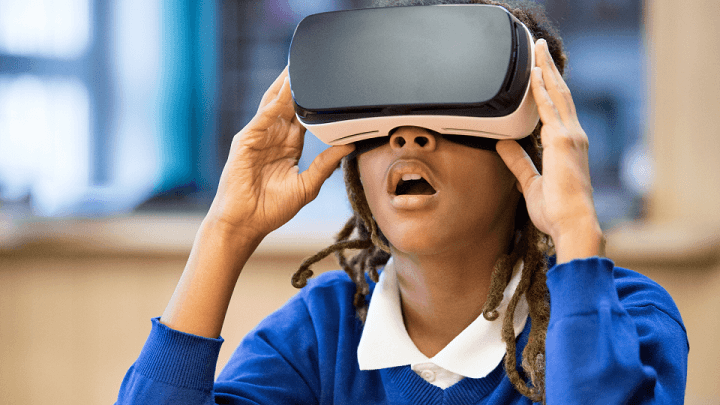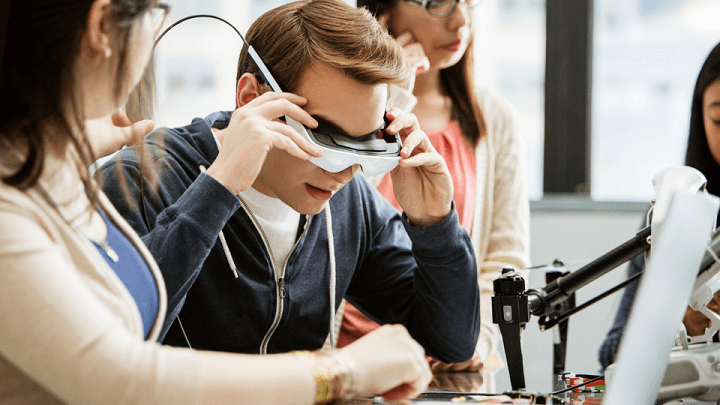We've partnered with The Telegraph to create a series of articles designed to help you embrace connectivity and use tech for good.

We've partnered with The Telegraph to create a series of articles designed to help you embrace connectivity and use tech for good.
Once they’ve “swum” with a shark, teachers are usually convinced of the value of virtual reality (VR) and what it can achieve. A swim with an apex predator is one of the hair-raising immersive experiences that teacher and education technology expert Simon Luxford-Moore offers staff in order to reveal the potential of immersive learning.
For six years he’s been helping teachers use VR across nearly all ages in the Edinburgh-based independent schools that comprise ESMS (Erskine Stewart’s Melville Schools). “We’re using it successfully; we’re not just dabbling,” he says. The schools have since become a local hub of expertise for other teachers.
Entering a virtual experience gives what he calls “that firework moment”—the feel, noise and thrill of a firework display that extends beyond the visual memory. “It’s an emotional connection,” he adds.
This captures the imagination of younger pupils who might become demotivated by an orthodox style of teaching. “In any lesson some children might not understand, and they will disengage. With VR, children experience something and engage emotionally because they ‘feel’ it—and remember it.”
In a recent geography lesson, he recalls, children took a virtual trip to the Himalayan peaks. “They literally sat on the floor of a sweltering classroom on one of the hottest days of the year, and said they felt cold—because in their headsets they were sitting on ice.”
He sees many improvements in pupil performance across the school, and particularly in the descriptive power of younger children. Working in pairs, four-and five-year-olds take turns to describe a virtual environment to their partner—this is followed up with a creative exercise. “And boys in particular at that age were able to describe things in ways they couldn’t have done before—as if they’d been on a school trip, for instance.”

VR has been around for at least two decades, but schools have been slow to adopt it—today it’s largely the domain of gamers, and headsets often sit in schools unused. It should never replace a teacher, says Luxford-Moore, who recommends children use headsets for no longer than about five minutes at a time, and no more than about 15-20 minutes in an hour. “If a child comes out and says ‘thanks for the VR lesson’, I know I’ve overdone the technology. If they say ‘thanks for the geography lesson’, that’s a hit.”
For the first time in the next school year, ESMS’s nursery-aged children will use VR to learn the basics of road safety. While researchers say that VR and augmented reality can help engage early years learners and give them confidence, there are caveats. Headsets can be clunky and expensive, and children can feel motion sickness with longer sessions. And shouldn’t very young children be learning through experience and social contact with others, asks child development expert Dr Amanda Gummer, founder of goodplayguide.com? “That rich learning you get from playing, touching, smelling and seeing is key, and social and communication skills are important... And I worry that VR would disincentivise school trips.”
Of course VR shouldn’t replace real experiences, particularly for younger children, says Luxford-Moore. But it can overcome barriers of geography, time and expense, if used correctly. Free of the safety fears of school trips, teachers can relinquish control and let pupils run free in virtual environments. “On a trip, you’d love them to explore, but you’re worried about losing a child… Ultimately VR is a resource, it’s meant to enhance rather than dictate learning.”
Parents are on board, he adds, because children go home and talk about their experiences with unprecedented enthusiasm. “So they get a better connection to their children’s learning.”

Outside of the classroom, there are so many ways parents and carers can be part of their child’s learning journey, and EE is on hand to support with a host of helpful tools.
EE LearnSmart will give kids access to a network of inspiring mentors—everyday experts with real world experience—that can help kids better navigate their way through school, and life. With snackable lessons, kids can pick up new skills that will help them get on and unlock exclusive partner rewards.
For parents keen to educate their child about mobile phone safety, EE PhoneSmart is the ideal companion. This is a free online course and certificate that prepares kids for the world of mobile phones by teaching them how to stay safe and be kind online. It’s available to any kids on any network.
EE GameSmart is another good set of tools to know; they help prepare children to game safely while remaining competitive, and also educate parents about gaming. Parents who play games with their children see the benefits, research shows—they say gaming boosts their child’s creativity, concentration and confidence. If you want to supercharge the experience, the Meta Quest 3 is an all-in-one VR headset that’s sure to ignite their imagination in new and extraordinary ways.